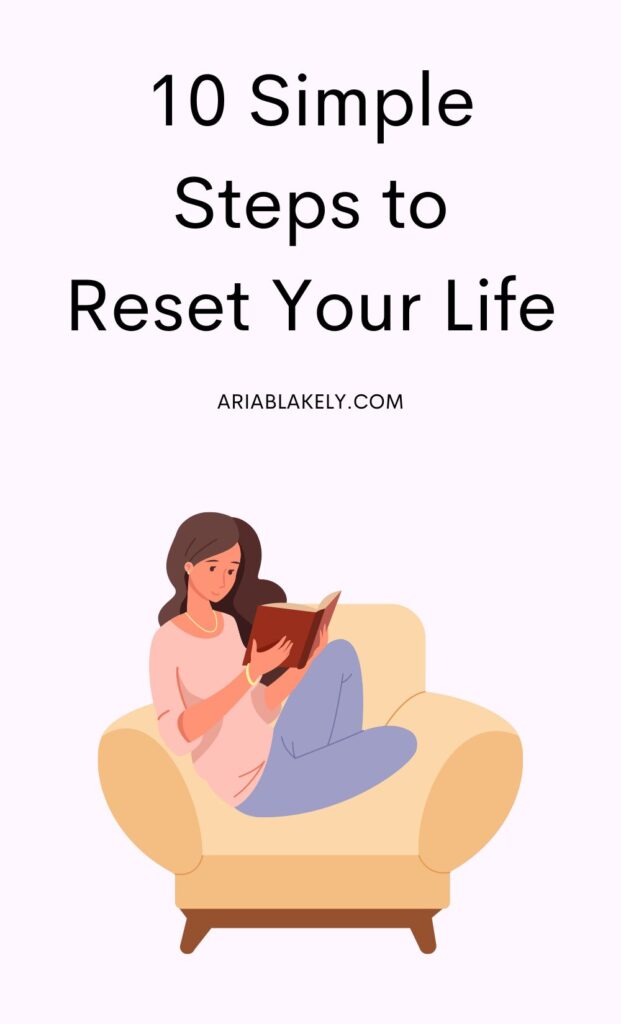Ever feel like you’re just going through the motions—stuck in a cycle of stress, bad habits, or just plain exhaustion?
Like life is running on autopilot, and no matter how much you try to “catch up,” you always feel behind?
We all hit moments where we feel lost, overwhelmed, or just disconnected from the life we truly want.
But here’s the good news: you don’t need a major life overhaul to reset your path.
A life reset isn’t about drastic changes—it’s about small, intentional shifts that help you feel more in control, energized, and aligned with what actually matters.
The best part? You don’t have to wait for a new year, a Monday, or some “perfect” time to start over. You can reset your life anytime—starting today.
“Although no one can go back and make a brand new start, anyone can start from now and make a brand new ending.”
Carl Bard
In this guide, I’ll walk you through 10 simple, practical steps to help you clear the mental fog, build better habits, and step into a version of your life that feels lighter, more fulfilling, and truly YOURS.
Reflect on Where You Are Right Now

Before you can reset your life, you need to understand where you currently stand.
It’s easy to feel stuck, but taking the time to reflect on what’s working—and what isn’t—can help you gain clarity and direction.
Many people rush into change without first assessing their current situation, which can lead to frustration or burnout.
Self-awareness is the foundation of growth.
A study published in Harvard Business Review found that people who practice self-reflection are more likely to set meaningful goals and make lasting improvements in their lives.
Practical Steps to Reflect on Your Life:
If you’re unsure where to start, try asking yourself:
- What areas of my life feel fulfilling?
- What parts of my routine feel draining or unaligned?
- What do I wish I had more of in my daily life?
- If I could change one thing right now, what would it be?
One powerful way to reflect is by doing a Life Audit:
- Grab a notebook and divide a page into four sections:
- Career & Finances
- Health & Well-being
- Relationships & Social Life
- Personal Growth & Happiness
- Rate each area on a scale of 1-10 (1 = needs major change, 10 = completely satisfied).
- Write down 2-3 things you’d like to improve in each category.
This simple exercise gives you a clear starting point so you can focus on what truly needs resetting in your life.
Don’t overcomplicate this step—set a 10-minute timer and just write freely. Your gut instincts will tell you what matters most!
Identify Your Core Values

Once you’ve taken the time to reflect, the next step is figuring out what actually matters most to you.
It’s hard to reset your life in a meaningful way if you’re unclear about your values—or if your day-to-day life is pulling you in a different direction.
When your actions aren’t aligned with your core values, it creates tension, burnout, and a general feeling of being “off.”
But when you live according to what you truly care about, life starts to feel more purposeful and grounded.
You stop chasing what others expect of you and start creating a life that actually fits.
How to Discover Your Core Values
Not sure what your values are? That’s okay—many people never pause to define them.
Here’s a simple way to get started:
- List 10 values that matter to you. Use prompts like:
- What makes me feel most like myself?
- What do I admire in others?
- What moments have felt the most meaningful in my life?
- Narrow it down to 3–5 core values that feel non-negotiable. These could be things like:
- Family
- Creativity
- Independence
- Spirituality
- Growth
- Honesty
- Ask yourself:
- Am I living in a way that reflects these values?
- If not, what changes could I make to realign my daily life?
Write your top 3 values on a sticky note or your phone’s lock screen. Seeing them daily is a gentle nudge to stay focused on what truly matters.
Declutter Your Physical and Mental Space

Sometimes the best way to reset your life is to start with your surroundings.
When your space is cluttered, your mind tends to follow suit.
Clearing out the physical noise around you can instantly bring a sense of clarity, calm, and control.
And it’s not just your physical environment.
Digital clutter, emotional baggage, and constant mental chatter all build up in the background, making it harder to focus or feel grounded.
You don’t need to gut your closet or alphabetize your spice rack.
Start small and focus on one area of your life. You might clear out a single drawer, tidy your nightstand, or finally tackle that corner of your desk you’ve been avoiding.
Digitally, you could unsubscribe from all those promo emails that flood your inbox or delete apps you haven’t used in months.
And mentally, try a quick brain dump: open a notebook and jot down everything that’s swirling in your head.
Just getting it out on paper can feel incredibly freeing.
Practical Tip: Set a 20-minute timer and choose one task. That’s it. A single focused decluttering session can reset your energy for the entire day.
Decluttering isn’t about perfection—it’s about making space for what matters and finally letting go of the things (and thoughts) that are just taking up room.
Reassess Your Daily Habits

If you’re feeling stuck or out of sync with your goals, chances are your daily routines have something to do with it.
The little things you do each day—often without even thinking—are shaping your reality more than you realize.
That’s why one of the most powerful ways to reset your life is to take an honest look at your habits.
James Clear, author of Atomic Habits, says, “You do not rise to the level of your goals. You fall to the level of your systems.”
In other words, if your routines don’t support the life you want, it’ll be nearly impossible to get there—no matter how strong your intentions are.
Even just one or two small changes in your day can have a ripple effect.
For example, swapping the habit of checking your phone first thing in the morning for five minutes of journaling or quiet reflection can completely shift your mindset for the day.
How to Audit Your Daily Routine
Start by observing your current habits for a day or two—without judgment.
- What do your mornings, afternoons, and evenings typically look like?
- Are there pockets of time where you feel unfocused, anxious, or drained?
- Do you notice any patterns that could be shifted or simplified?
Once you have a sense of your rhythms, pick one habit that isn’t serving you and replace it with something better.
If you usually scroll social media during lunch, try going for a short walk instead.
If your evenings feel chaotic, experiment with a wind-down routine that includes screen-free time, a cup of tea, or even just five minutes of quiet.
Don’t try to change everything at once. Choose one habit to adjust this week and build from there. Small shifts create big momentum.
Resetting your life isn’t about hustling harder—it’s about being intentional with the moments you already have.
Set Small, Achievable Goals

It’s easy to feel overwhelmed when you think about everything you want to change or accomplish.
That’s why setting small, realistic goals is one of the most effective ways to reset your life—because big changes actually happen through tiny, consistent actions.
Here’s the truth: huge, all-or-nothing goals often backfire.
They’re exciting at first, but when motivation fades (and it always does), they can leave you feeling discouraged or like you’ve failed.
But when you break those big dreams into bite-sized, doable steps, you build momentum. And momentum is powerful.
Psychologists call this the “goal-gradient effect”—the closer you feel to completing a goal, the more likely you are to follow through.
That’s why achieving small wins regularly can boost your confidence and keep you moving forward.
How to Set Goals That Actually Stick
Start by choosing one area of your life you’d like to focus on—maybe it’s your health, career, personal growth, or relationships.
Then ask yourself: what’s one small thing I can do this week that supports that area?
- Instead of “get in shape,” try “go for a 15-minute walk three times this week.”
- Instead of “start a business,” try “brainstorm 3 ideas and write them down.”
- Instead of “fix my finances,” try “review my bank account and cancel one unnecessary subscription.”
Use the 1-3-5 rule: write down 1 big goal, 3 medium goals, and 5 small goals you can work toward this month. Focus on progress, not perfection.
You don’t need to map out your entire future—you just need a clear next step.
One small goal at a time, you’re building a life that feels intentional and aligned with who you want to be.
Reset Your Mindset

Sometimes the biggest obstacle standing in your way isn’t your schedule, your job, or your environment—it’s the voice in your head telling you that you can’t.
That you’re not ready. That it’s too late. Resetting your life means learning how to recognize and release the beliefs that are holding you back.
What Are Limiting Beliefs?
Limiting beliefs are the quiet narratives we carry—often formed early in life—that shape the way we see ourselves and our potential.
Maybe you’ve told yourself, “I’m just not a confident person,” or “I always mess things up,” or “People like me don’t get to live that kind of life.”
These thoughts may feel true, but they’re usually just old stories we’ve never questioned.
Your beliefs influence your actions.
If you believe you’re not good at relationships, you might avoid vulnerability or close yourself off.
If you believe you’re not smart enough, you might not apply for that job or start that project.
But when you start to challenge these thoughts, your actions begin to shift—and that’s where growth begins.
As mindset coach Carol Dweck explains in her work on the growth mindset, people who believe they can change and improve over time are far more likely to succeed—not because they’re naturally talented, but because they don’t let failure define them.
How to Identify and Replace Limiting Beliefs
Start by noticing your internal dialogue, especially when you feel stuck or afraid. Ask yourself:
- What am I telling myself right now?
- Is this absolutely true—or just a fear or assumption?
- What’s a more helpful, empowering thought I can choose instead?
Write down one belief that’s been holding you back—and underneath it, write a more supportive version.
For example:
“I always fail” becomes “I’ve struggled in the past, but I’m learning and growing.”
Read it aloud. Every time you repeat it, you’re rewiring your brain in a healthier direction.
You don’t have to believe every thought that crosses your mind.
In fact, learning to talk back to that inner critic might be one of the most life-changing things you ever do.
Self-Care

Resetting your life doesn’t mean working harder—it means resting smarter.
In a world that glorifies hustle and productivity, taking time to rest can feel like a luxury… or worse, like laziness.
But here’s the truth: rest is not a reward—it’s a requirement.
Why Self-Care Isn’t Optional
When you’re constantly pouring from an empty cup, burnout becomes your default.
According to the National Institute of Mental Health, prioritizing rest and self-care is essential for managing stress, maintaining emotional balance, and improving overall well-being.
And yet, it’s often the first thing we neglect when life gets busy.
Self-care doesn’t have to be expensive or time-consuming.
It can be as simple as stepping outside for fresh air, journaling before bed, or saying no to one thing that drains your energy.
If your schedule is packed, start small.
Instead of overhauling your entire routine, choose one restful activity to protect each day—like a short walk after lunch, a warm bath before bed, or five minutes of deep breathing in the morning.
Also, don’t underestimate the power of intentional stillness.
A Sunday afternoon nap, an unplugged hour with your favorite book, or simply sitting quietly with your thoughts can feel incredibly grounding.
Practical Tip: Block out time in your calendar for rest and self-care—just like you would a meeting or appointment. If you don’t schedule it, it probably won’t happen.
Caring for yourself isn’t selfish—it’s the foundation that allows you to show up fully for your work, your relationships, and your goals.
Create a Plan for Your Finances

Let’s be honest—money stress has a way of creeping into everything.
It affects your sleep, your relationships, your energy, and even your confidence.
If you’re resetting your life, your finances deserve a spot on that list too.
You don’t need to become a budgeting expert overnight, but having a clear, simple view of where your money is going can bring instant relief and empowerment.
According to the American Psychological Association, money is one of the top sources of stress for adults in the U.S., yet many people avoid dealing with it because they feel overwhelmed or ashamed.
But here’s the good news: even small steps can lead to major breakthroughs.
How to Reset Your Finances
Start by reviewing your spending from the last month.
You don’t have to go line-by-line if that feels intimidating—just get a general sense of where your money is going.
Look for patterns. Are there subscriptions you forgot about? Impulse purchases that don’t align with your goals?
Once you’ve got the lay of the land, set one simple financial goal for the next month.
It could be something like saving $50, cooking more at home instead of ordering out, or putting a limit on how much you spend on non-essentials.
Use a free app like Mint or You Need a Budget (YNAB) to track your spending automatically. Even five minutes a week can help you stay on track and feel more in control.
Money can be a source of stress—or a source of freedom.
Taking just a little time to understand it better is one of the most empowering parts of a life reset.
Step Outside Your Comfort Zone

If you want a different life, you have to be willing to do something different. And that usually means getting a little uncomfortable.
Resetting your life isn’t just about simplifying and resting—it’s also about awakening a part of you that’s ready to grow, explore, and experience new things.
Comfort zones feel… well, comfortable. But they can also quietly hold you back. Over time, staying in the same routines, roles, and thought patterns can make life feel stagnant.
But, stepping outside your comfort zone—even in small ways—boosts confidence, builds resilience, and sparks creativity.
This doesn’t mean you need to take a huge risk or make dramatic changes.
Growth can start with something small—something that stretches you just enough to prove to yourself that you’re capable of more.
How to Challenge Yourself
Think about one thing you’ve always wanted to try, but haven’t.
Maybe it’s starting a blog, joining a local class, attending an event solo, or simply speaking up in a group setting.
Pick something that feels exciting, even if it’s a little nerve-wracking.
I still remember the first time I signed up for a writing group. I almost canceled three times—but walking into that room turned out to be one of the best decisions I made that year.
It reminded me that I was braver than I gave myself credit for.
Practical Tip: Write down one thing that scares you just enough—then give yourself a 7-day deadline to try it. Don’t overthink it. Action builds courage.
Every time you stretch beyond what feels familiar, you grow into someone stronger.
Someone more aligned with the life you’re building.
Surround Yourself with Positivity

You can do all the inner work in the world, but if your environment is draining or your relationships constantly pull you down, it’s going to be hard to move forward.
That’s why the final step in resetting your life is to take a close look at the people, energy, and messages you allow into your space.
“You are the average of the five people you spend the most time with.”
Jim Rohn
Studies show that our behaviors, moods, and even health choices are heavily influenced by our social circles.
If you’re surrounded by negativity, criticism, or constant comparison, it slowly chips away at your self-worth and motivation.
On the flip side, positive, supportive people help you rise. They inspire you, remind you of your potential, and celebrate your wins without judgment.
How to Build a More Positive Circle
Start by noticing how you feel after spending time with certain people—energized or exhausted? Encouraged or subtly judged?
You don’t have to cut everyone off (this isn’t a soap opera!), but you can gently create more space around toxic dynamics and lean into connections that feel life-giving.
And don’t forget: your “circle” includes what you consume too.
The podcasts you listen to, the social media you scroll, the books you read—they all feed your mindset.
Practical Tip: This weekend, unfollow 5 accounts that make you feel “less than,” and follow 5 that inspire, educate, or uplift you. Curate your environment like your life depends on it—because in many ways, it does.
Surrounding yourself with positivity doesn’t mean everything will be perfect.
It means you’re giving yourself the best possible chance to grow, reset, and thrive.
For You

Thank you for sticking with me through this (and yep—sorry for the long post!).
But sometimes, the things that matter most take a little time to unpack.
If you’ve made it this far, that already says something important—you’re ready.
You’re not just coasting anymore. You’re looking at your life, noticing where it feels heavy, and you’re searching for ways to shift. That matters.
The truth is, we all reach moments when we need to pause, take a breath, and re-evaluate what we’re carrying.
Resetting isn’t about fixing yourself—it’s about reconnecting with who you already are beneath the stress, the routines, and the noise.
To anyone out there feeling lost, stuck, or unsure where to go next—I hope this gives you a gentle starting point. You don’t need to do everything at once. You don’t need a perfect plan.
You just need one clear, loving decision to show up for YOURSELF… starting now.

